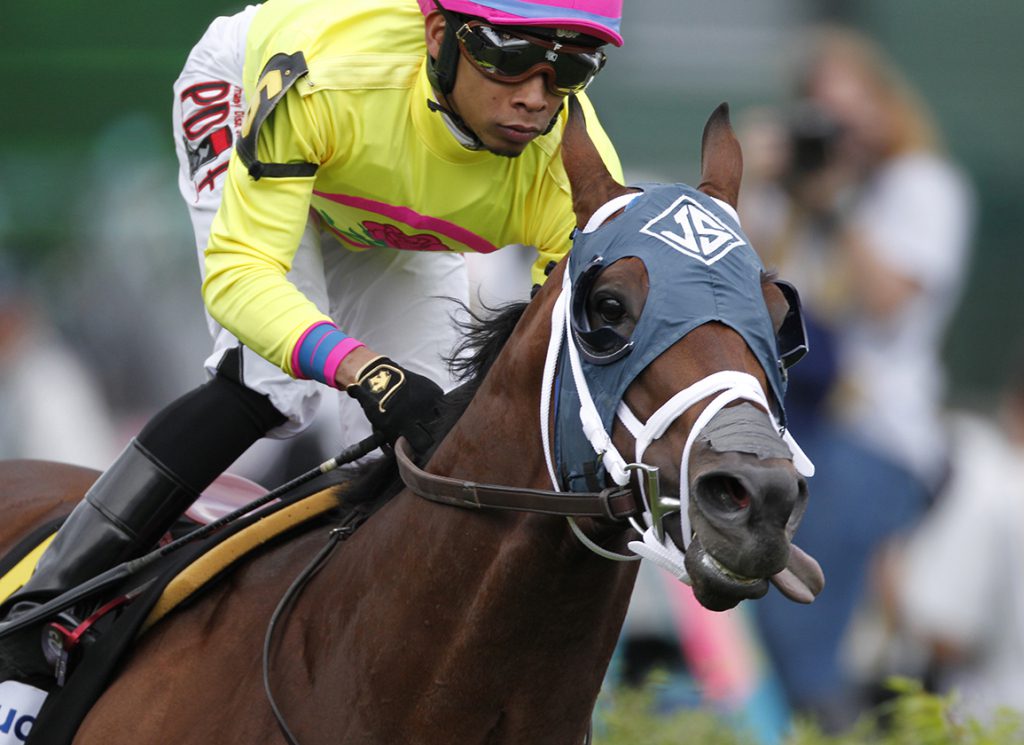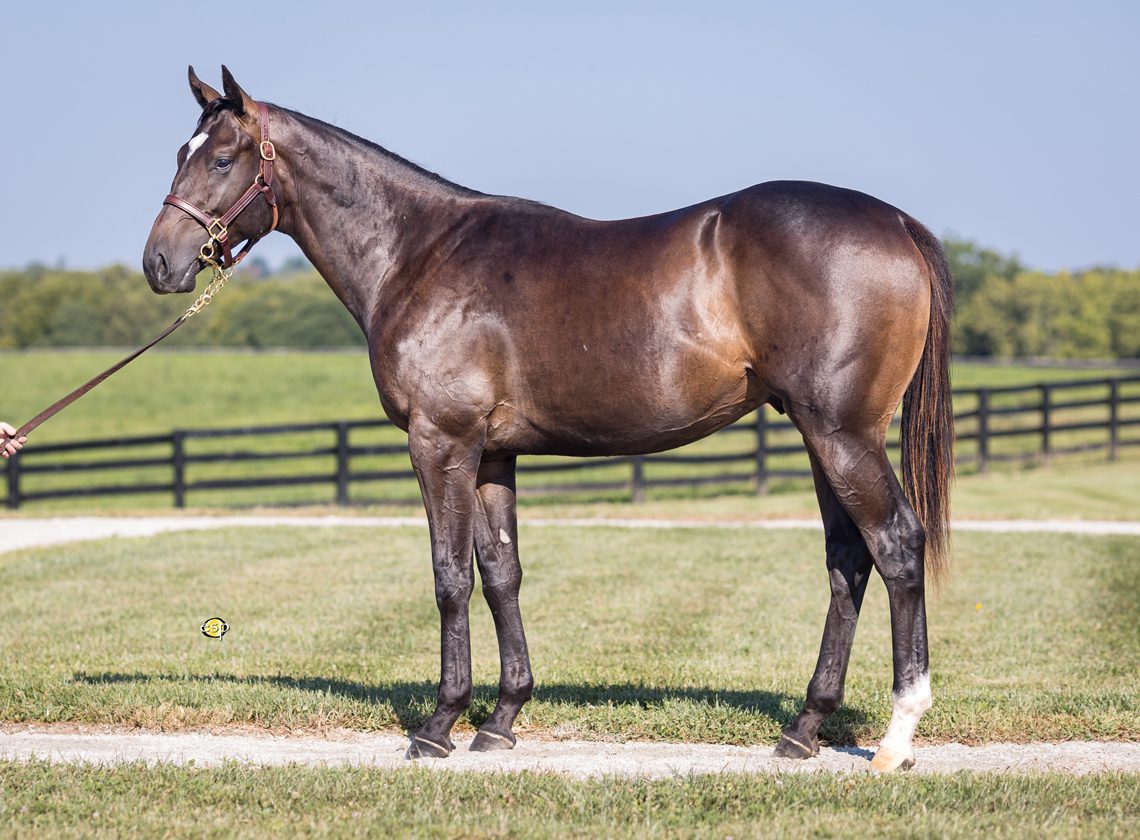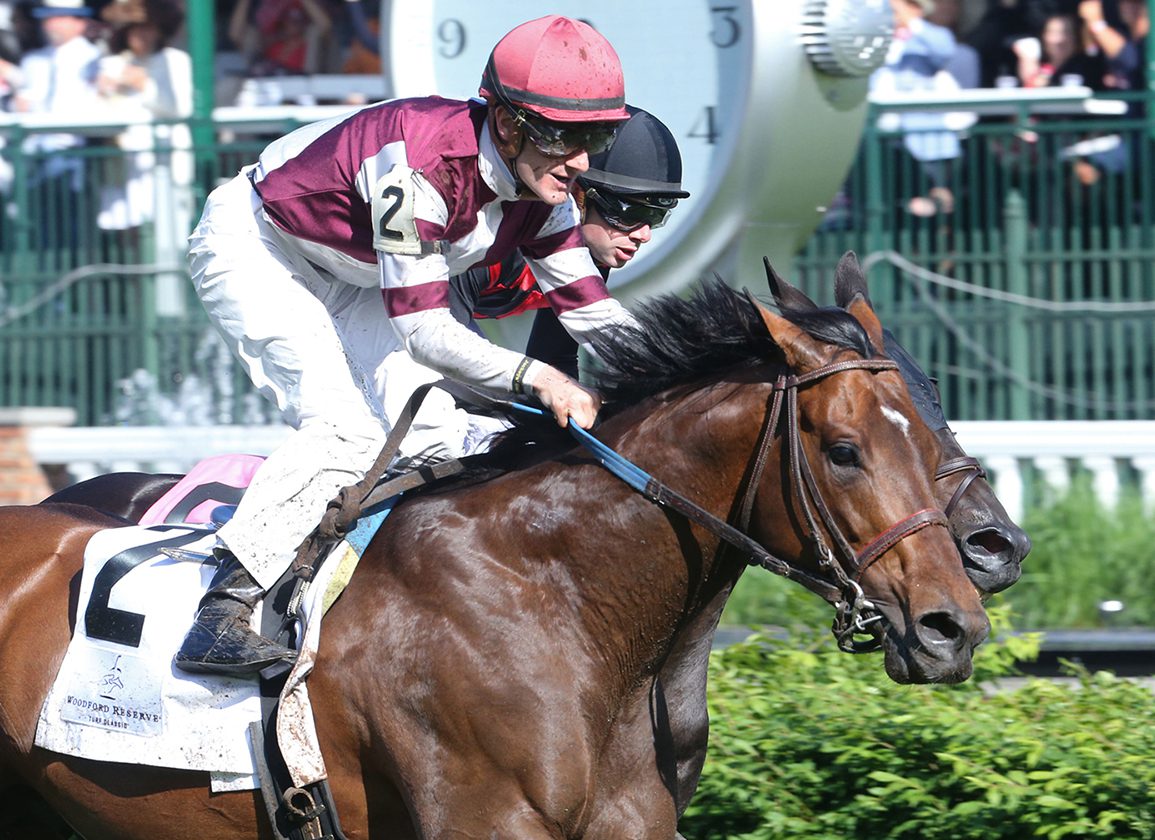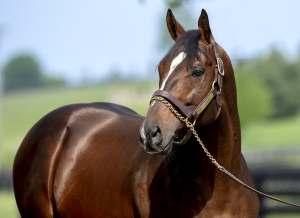No getting away from it, the young stallions we assess today have already completed their service to many breeders. They've processed a debut crop of yearlings, often on an industrial scale, and many have obliged with the kind of averages that vindicate the familiar, self-fulfilling commercial cycle that so favors new sires: demand generating supply, and the quality incidental to that increased supply in turn increasing demand.
That leaves us with another tricky podium. You can't just congratulate those who have “won” on this system, topping out the first-crop yearling averages. Because the ostensible losers, the ones with disappointing yields and sliding fees and books, have an imminent opportunity to show that they can produce horses that actually run. As such we have remained loyal to a couple of longstanding favorites.
Even for those that meet the initial challenge, it can be a ruthless system. If there's anything more ridiculous than the fidelity to unproven new sires it's the impatience with which most will be promptly abandoned. It's impressive, then, to see how some farms that deal unabashedly in volume are striving to prolong that brief window of opportunity. They might do so with incentive schemes, or by using their home herds, or with the precarious (but true) sales pitch that it's perseverance now-precisely when other breeders are backing nervously away from racetrack exposure-that would yield the biggest return with those sires that do actually elevate their reputation, once people can judge their stock not on a sales dais but out of a starting gate.
Those breeders subscribing to a fourth book this spring know that the resulting foals will enter yearling catalogues at a time when their sires have had a proper chance to show their wares. The first crop will have reached maturity; the second will have had their own crack at the Triple Crown; and a third crop of juveniles will meanwhile have launched. That's why maintaining the flow is so helpful: with a “loaded pipeline,” any stallion that does land running has a chance to keep his name in lights pending the production of foals delivered by the better mares arriving to pay a rising fee.
The farm that dominated this intake-recruiting its first, second and joint-third most expensive start-ups, as well as a cheaper one with outstanding commercial appeal-did so as a striking adaptation of its success with cheaper stallions that had been promoted by various pioneering incentives. Spendthrift could make this upgrade using more conventional, fee-based math. But other hallmarks of its dynamic program remained applicable. Knowing that turnover would be high, they could pitch even these better stallions at a relatively tempting fee; and the dividends duly achieved at the sales by many clients can now be played up, if so disposed, by returning to the same stallion at a reduced fee.
The system has been working smoothly, not only for Spendthrift but for others operating on a similar scale, with several of these stallions having maintained high turnover into third books last season; and largely vindicated, meanwhile, at the yearling sales. But now, in 2023, comes the crunch. We'll begin to find out whether the huge opportunity earned by these stallions will actually be seized by the cavalry of juveniles approaching the gate.
And who knows? We often see these prolific newcomers, with their hundreds of mares, overtaken by neglected rivals once the time comes for deeds, not words.
Bubbling Under:
Measured purely by their auction reception, this intake appears to have registered some pretty strong trends already. Certain sires will be launching their first runners with some conspicuous contrasts in the levels of market confidence behind them.
The big winners, it must be said, have largely worked the numbers game: the four highest averages by debutants at the yearling sales, in fact, were all achieved by the only four stallions that sent over 100 into the ring. To a degree, however, “that horse has bolted.” The quest for value, in the longer term, requires at least some attempt to swim against the tide. Yes, the top gun on our podium happens to be the top gun at the sales-but, as we'll see shortly, we feel he retains plenty of eligibility measured strictly in terms of value.
In the meantime, AUDIBLE certainly deserves a moment of congratulation. Yes, he's one of those that have assembled a staggering harem, starting with a book of 221 and since following through with 189 and 148. But while the sheer breadth of his catalogue footprint will obviously have resulted in a wide spectrum of vendor experiences, he has responded with plenty of headlines.
After reaching $103,813 with his first weanlings, he sold as many as 111 of the 123 offered as yearlings for an average $147,072. Almost inevitably, their progress was not quite so dramatic when measured by median, up to $110,000 from $87,000. But that does mean some major scores were celebrated (topped by a $725,000 colt at Keeneland September).
What's huge for this fellow, however, is that the weanlings offered from his second crop held up exceptionally well. He sold 18 of 22 offered at $96,277 ($87,500 median) and, after a mild clip to $22,500 last year, that has helped WinStar restore his opening fee of $25,000. Anyone with a stake in Audible will be feeling justifiably excited.
MAXIMUS MISCHIEF, another son of Into Mischief, we have long highlighted as too blatant a commercial play not to succeed. He duly received all the numbers that seemed inevitable and has proved equal to that turnover at the sales, advancing his $42,777 weanling average last year to $57,019 for 77 yearlings sold of 93 offered. He takes a break from the podium only because his weanling/yearling medians were essentially stagnant ($39,000/$40,000), while his second crop of weanlings slipped to an average of $25,000 for just 13 sold of 23.
His precocious profile almost guarantees some big pinhook scores in Florida next spring, however, and conceivably enough early momentum on the track to have a role in the freshman championship. That's certainly the way his supporters must be thinking, as he has followed opening books of 198 and 171 by receiving another 195 mares in his third year at Spendthrift-a pretty stunning vote of confidence. He remains virtually a bet to nothing at $7,500.
Another standing at the same fee, FLAMEAWAY, drew some attention at the yearling sales. Though a tier below the best of his crop, he has been given the volume necessary to recycle versatility and durability of an elite European family. The son of Scat Daddy corralled no fewer than 183 mares in his debut season at Darby Dan, and processed 66 of the 85 offered as yearlings for $49,340-doubling their weanling average of $25,720-including a $425,000 colt at Saratoga. He has maintained three-figure books over the past couple of years, so has every chance of consolidation if igniting on the racetrack from these sparks of commercial promise.
BRONZE: PRESERVATIONIST (Arch-Flying Dixie by Dixieland Band)
$10,000 Airdrie
If you liked this fellow at the outset-and I loved him-then why on earth would you leave precisely at the moment he can turn the dial in his favor?
As a rule, I feel nervous of sires with a major deficit between average and median in their first market testing. But that's more of an issue, to me, with overtly commercial sires trading huge books. The fact is that a horse with Preservationist's profile was never going to start out with consistent demand across the modern marketplace. He was always going to appeal to more far-sighted breeders, who recognized a precious genetic package at an affordable price; and who reckoned him eligible to put a winner under their mare, while hoping that his excellent physique might in the meantime yield the odd score in the sales ring.
And he got plenty of those. Prices like $280,000, $260,000 and $250,000 represented home runs that could only be envied by many who felt they had made a more commercial wager. (And remember that the colt he got into the first session of the September Sale, a rare distinction for a $10,000 rookie, had to be scratched.) Overall Preservationist averaged $40,542 for 47 yearlings sold of 59 offered.

Preservationist | Sarah Andrew
Predictably enough, his books dwindled through his second and third years but he did have a three-figure team to get him started and has obviously produced some pretty striking specimens among them. His own template might suggest that there is a long road to ride first, as he was six when he won his Grade I going two turns. But actually he had plenty of speed, breaking his maiden in 1:09.35. And, besides, anyone who rowed in with him will primarily have been excited that such regal lines–putting King Ranch matriarchs Courtly Dee and Too Chic opposite each other–should have combined to produce an animal of elite appearance ($485,000 yearling when his sire was standing for $30,000) and performance.
The four mares in his dam's third generation include Natalma, Weekend Surprise and Too Chic; and the dynasty (18 graded winners under first three dams!) has been freshly decorated by the emergence of Olympiad, who is out of a half-sister to Preservationist's dam. The latter was herself sadly lost after just two foals, and it's interesting to note that the other ran 46 times and stakes-placed at eight. We know that a son of Arch with his first two dams by Dixieland Band and A.P. Indy will put a lot of “run” into the sheer class of this pedigree. If he only has a fleeting commercial opportunity, at least to start with, here's a horse equipped to draw every last ounce of merit from your mare.
It just feels very auspicious that Preservationist should have produced several yearlings with serious commercial appeal. The bottom line is that no horse in this intake would surprise me less, if happening to turn up a Kentucky Derby winner-and that's not the way he is priced.
SILVER: WORLD OF TROUBLE (Kantharos-Meets Expectations by Valid Expectations)
$5,000 Hill 'n' Dale
I know, I know. This is beyond bold. Because this horse feels aptly named right now. His third book dwindled to 27, and he's now standing at one-third of his opening fee. And there's an obvious reason why. Let's put a name to the elephant in the room: Jason Servis. This was an ex-claimer elevated to stardom by a man facing jail for a doping program.
But let's do something that sets us apart from that person, and try to show some respect to the horse. Sharp Azteca, after all, was trained by another confessed villain in Jorge Navarro-but demonstrably has the genetic merit, whatever suspicions people may have nursed, to have sired more individual winners this year than any other freshman.
World of Trouble, remember, flaunted a ton of natural ability for another trainer before joining Servis, winning by 14 lengths on debut and then beaten half a length in a stakes race, miles clear of the rest, despite bumping the rail. Whatever else may (or may not) have been assisting him later on, moreover, it takes unusual and inherent flair to switch from dirt to turf as indifferently as did World of Trouble when posting his big numbers in the GI Carter H. and GI Jaipur Inv.
So, whatever fears or suspicions people may have, this was an uncommon horse in his own right. And I just feel that he perhaps deserves a second chance after an intriguing market debut, given the reservations that will have been nursed–rightly or wrongly–by many investors.
On the face of it, an average $40,756 for 46 yearlings sold of 56 offered was no more than solid. Of this whole intake, however, no other sire achieved a median ($37,000) so close to his average. Where a lot of his peers were boosting their averages with a handful of home runs from some pretty enormous books, World of Trouble was looking after the people who had used him in a far more consistent way.
A ceiling of $170,000 might be relatively unspectacular, but even that is hugely creditable in such difficult circumstances. And, by giving his stock a platform to demonstrate whether or not they can actually run, one or two pinhookers may end up banking a major dividend from that kind of base come the 2-year-old sales.
Remember that World of Trouble was bred to be very fast. His dam is a Valid Expectations half-sister to prolific sprinter Bucchero-himself, of course, by World of Trouble's sire Kantharos.

World of Trouble | Horsephotos
Look, I don't know. But nor do any of us. I feel sorry for the horse and for any who, having acted in good faith, now find themselves facing steep odds-whether the excellent farm that stands him, or its clients. And the fact is that people obviously liked his stock well enough, perhaps almost despite themselves.
Just imagine if it turns out that everyone has been doing World of Trouble an injustice, and he proves able to throw that speed as a natural genetic inheritance? It's not impossible, and the gamble can now be tried at very small stakes.
GOLD: OMAHA BEACH (War Front-Charming by Seeking The Gold)
$30,000 Spendthrift
All they have to do now is show that they can run. Because if a stallion's career were confined only to a market launch-and that, of course, is precisely how many breeders view things-then this fellow would be quite a paragon.
It might seem pointless, to highlight the guy with the top fee and (by a street) top average of this class. But we've had him on the podium throughout, purely as a value call, and he can only ascend to the top step now that he has delivered in such spectacular fashion at the sales-even as he has taken repeated cuts in fee.
Omaha Beach has proved an ideal vehicle for this particular system: a tempting fee based on high volume; a good yield, as a result, for very many breeders (if obviously not all); in turn incentivizing repeat custom at a diminished fee; and so opening a new cycle.
We liked him even at $45,000, so how could we resist at $35,000 and then $30,000? He was still the same package, a brilliant speed-carrying grandson of Danzig from a celebrated family. And all that has happened in the meantime is that his stock has passed its first auction test with flying colors.
What we especially like is that his excellent weanling returns last year have turned out just to be a base for giddy additional gains: he advanced his $112,736 weanling average ($95,000 median) to $201,689 for 81 yearlings sold of 105 offered ($160,000 median). That's some collective “pinhook”! If these horses are impressing ever more, as they mature, then that has to augur well for the 2-year-old sales next spring-and also, naturally, for their introduction to what is supposed to be their real purpose in life.
Of course, a third consecutive book of over 200 can only work if he now delivers in that way, too. But if he does, this will potentially be the last opportunity to remain ahead of the value curve. As noted above, Audible has also done everything his supporters could have hoped, to this point. But he will cost you $25,000, just as he did at the outset, whereas Omaha Beach will now require only an extra $5,000, instead of an extra $20,000.
By no means all of us feel comfortable with the industrial model that has developed both horses, but they have shown how it can function at its most efficient. And, having started out at the higher fee, Omaha Beach will presumably have received superior mares, too: quality, in other words, to match the quantity.
This time next year, will he have produced the flagship horses to start moving his fee back up? That's the next gamble, but this horse obviously has a lot of believers. And, if you do believe, now is the time to double down.
The post Value Sires for ’23, Part IV: First Runners Due appeared first on TDN | Thoroughbred Daily News | Horse Racing News, Results and Video | Thoroughbred Breeding and Auctions.






